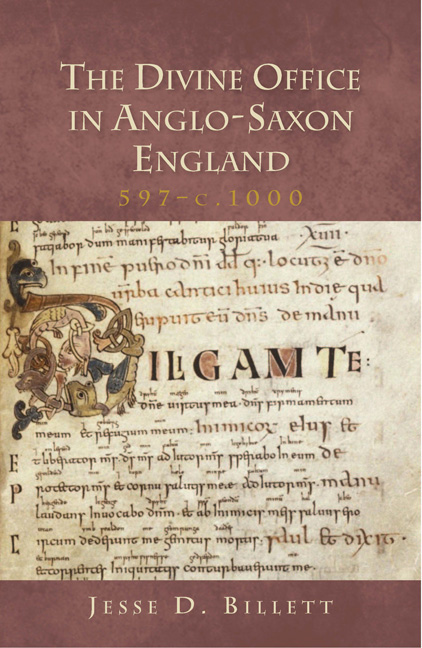Book contents
- Frontmatter
- Dedication
- Contents
- TABLES
- ILLUSTRATIONS
- PREFACE
- NOTE ON USAGE
- ABBREVIATIONS
- MANUSCRIPT SIGLA
- Part I The Historical Development of the Divine Office in England to c.1000
- 1 TOWARDS A ‘NEW NARRATIVE’ OF THE HISTORY OF THE DIVINE OFFICE IN ANGLO-SAXON ENGLAND
- 2 THE DIVINE OFFICE IN THE LATIN WEST IN THE EARLY MIDDLE AGES
- 3 THE DIVINE OFFICE IN ENGLAND FROM THE AUGUSTINIAN MISSION TO THE FIRST VIKING INVASIONS, 597–c.835
- 4 THE DIVINE OFFICE IN ENGLAND FROM THE FIRST VIKING AGE TO THE ABBACY OF DUNSTAN AT GLASTONBURY, c.835–c.940
- 5 THE DIVINE OFFICE AND THE TENTH-CENTURY ENGLISH BENEDICTINE REFORM
- Part II Manuscript Evidence for English Office Chant in the Tenth Century
- Appendices
- BIBLIOGRAPHY
- INDEX OF MANUSCRIPTS
- INDEX OF LITURGICAL FORMS
- INDEX OF BIBLICAL REFERENCES AND LITURGICAL READINGS
- GENERAL INDEX
5 - THE DIVINE OFFICE AND THE TENTH-CENTURY ENGLISH BENEDICTINE REFORM
from Part I - The Historical Development of the Divine Office in England to c.1000
Published online by Cambridge University Press: 05 November 2014
- Frontmatter
- Dedication
- Contents
- TABLES
- ILLUSTRATIONS
- PREFACE
- NOTE ON USAGE
- ABBREVIATIONS
- MANUSCRIPT SIGLA
- Part I The Historical Development of the Divine Office in England to c.1000
- 1 TOWARDS A ‘NEW NARRATIVE’ OF THE HISTORY OF THE DIVINE OFFICE IN ANGLO-SAXON ENGLAND
- 2 THE DIVINE OFFICE IN THE LATIN WEST IN THE EARLY MIDDLE AGES
- 3 THE DIVINE OFFICE IN ENGLAND FROM THE AUGUSTINIAN MISSION TO THE FIRST VIKING INVASIONS, 597–c.835
- 4 THE DIVINE OFFICE IN ENGLAND FROM THE FIRST VIKING AGE TO THE ABBACY OF DUNSTAN AT GLASTONBURY, c.835–c.940
- 5 THE DIVINE OFFICE AND THE TENTH-CENTURY ENGLISH BENEDICTINE REFORM
- Part II Manuscript Evidence for English Office Chant in the Tenth Century
- Appendices
- BIBLIOGRAPHY
- INDEX OF MANUSCRIPTS
- INDEX OF LITURGICAL FORMS
- INDEX OF BIBLICAL REFERENCES AND LITURGICAL READINGS
- GENERAL INDEX
Summary
The history of the Divine Office in England from the Augustinian mission to the first decades of the tenth century, which has been reconstructed in the preceding chapters, may be briefly summarized as follows. A Roman form of the Office was introduced to England in the early seventh century, perhaps by the Roman missionaries, and by the middle of the eighth it had effectively supplanted the forms of the Office derived from British, Irish, or Gallican traditions that must previously have had some currency in England but which have left no trace and whose forms cannot be reconstructed with any certainty. This seventh-century Roman Office was enriched with material from various traditions while maintaining its structural integrity. Outside England, the Roman Office was subjected to various modifications, both in Rome itself, where the Office continued to evolve, and in Frankish Gaul, where the Roman Office was adapted and standardized in distinctive ways. The little evidence that survives suggests that some English churches kept pace with these developments while others conservatively maintained the earlier tradition. Either approach could legitimately be claimed as ‘Roman’. There is no evidence that separate forms of the Office were used by secular and monastic churches – and these labels are in any case problematic when speaking of the early centuries. In particular, there is no evidence that the form of the Office described in the Regula S. Benedicti was used anywhere in England, despite the importance of the Rule in English monastic life.
- Type
- Chapter
- Information
- The Divine Office in Anglo-Saxon England, 597-c.1000 , pp. 149 - 196Publisher: Boydell & BrewerPrint publication year: 2014



